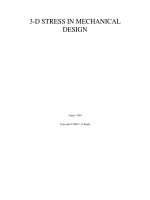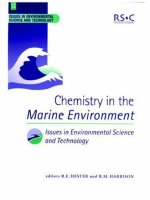Molecular Biotechnology-Lession 3: Basic techniques in DNA technology ppt
Bạn đang xem bản rút gọn của tài liệu. Xem và tải ngay bản đầy đủ của tài liệu tại đây (1.08 MB, 62 trang )
Molecular Biotechnology
Tran Ngoc Duc, PhD
VIETNAM NATIONAL UNIVERSITY AT HO CHI MINH CITY
INTERNATIONAL UNIVERSITY
Basic techniques in DNA
technology
1. Polymerase chain reaction (PCR)
2. Gel electrophoresis
3. Primer Design
4. RT-PCR
5. Digestion
6. Southern blot/Northern blot
7. Detectable signal based techniques
8. Site-directed mutagenesis
Polymerase chain reaction
1. PCR and Primer Design
Developed in 1983 by Kary Mullis
Polymerase Chain Reaction is widely held as one of
the most important inventions of the 20th century in
molecular biology. Small amounts of the genetic
material can now be amplified to be able to a identify,
manipulate DNA, detect infectious organisms, including
the viruses that cause AIDS, hepatitis, tuberculosis,
detect genetic variations, including mutations, in human
genes and numerous other tasks.
Components in PCR reaction
Template DNA
Primers
dNTPs
Taq DNA polymerase
Buffer
Step 1: Denature DNA, 95
o
C, 5min
Step 2: Annealing:
- Denature DNA, 95
0
C, 30s-1min
- Annealing, 55-60
o
C, 1min
Step 3: Extension, 70-72
o
C, 30s-1min
Go to step 2, 32 cycles
Step 4: Holding, 4
o
C, 0s
Steps programmed in PCR
Exponentially amplifying a single or some piece of
DNA generating thousands of million copies of DNA
Total copies = 2
n
where n is the number of cycles to
copy DNA
So basically it is the cycles of heating and
cooling (thermal cycling)
Applications of PCR
DNA cloning
DNA based phylogeny
Functional analysis of gene
Hereditary diseases
Forensic sciences
Infectious diseases
2. Gel electrophoresis
A method for separating mixture of charged molecules
such as DNA, RNA or proteins under an electric field when
an electric field is applied to them
The gel acts like a sieve for separation of molecules
according to their sizes and electric charges
Gel is made of agarose for separating large molecules of
DNA, and of acrylamide for protein separation or small
DNA or RNA
Proteins, unlike nucleic acids, can have varying charges
and complex shapes, therefore they may not migrate into
the polyacrylamide gel at similar rates, or at all, when
placing a negative to positive on the sample.
In the case of nucleic acids, the direction of migration,
from negative to positive electrodes, is due to the
naturally-occurring negative charge carried by their sugar-
phosphate backbone
After the electrophoresis is
complete, the molecules in the gel
can be stained to make them visible.
Ethidium bromide, silver, or
Coomassie Brilliant Blue dye may be
used for this process.
If the molecules to be
separated contain radioactivity
added for visibility, an
autoradiogram can be recorded
of the gel
Protein electrophoresis
Step 1: Denature DNA, 95
o
C, 5min
Step 2: Annealing:
- Denature DNA, 95
0
C, 30s-1min
- Annealing, 55-60
o
C, 1min
Step 3: Extension, 70-72
o
C, 30s-1min
Go to step 2, 32 cycles
Step 4: Holding, 4
o
C, 0s
Steps programmed in PCR
Primers (short DNA fragments) containing sequences
complementary to the target region along with a DNA
polymerase
Pair of primers should have similar annealing Ta,
which is usually 4-5
0
C below Tm
One primer is complementary to one end strand of DNA
Primer length usually 18-24bp, shouldn’t be over 30
GC, 40-60%
Ta = (2AT+ 4GC) - 4
Primer shouldn’t form hairpin or loop by themselves
Ta of the 2 primers shouldn’t be big different
ATGCCCTCCACTTCCGGTGCGTCGCCCTTCCTCCCAGCAGCGCCAGCACTTGCCAG
GCGGTGCAGTCGCGGCCCCAACGGCAGCAGCAGGCGGTGCAGCAGGGCGGTGCCAG
GGCCTGCGCTGGAGGGGCGGAGCGCTGGAGGCAGCGTACGAGCGGTGTGGCGCGGT
GTGCAAGGAGTACGCCAAGACCTTCTACCTGGGCACGCAGCTCATGACCCCCGTCC
AGGCACGCTGCATCTGGGCCATCTACGTGTGGTGCAGGCGCACGGATGAGCTGGTG
GATGGCCCTAATGCCTCCAAGATCACACCACAGGCCCTGGACCGGTGGGAGGAGCG
F:?
R:?
Ta=?
Ta=?
/>
The melting temperature (T
m
) is the temperature at which one-
half of a particular DNA duplex will dissociate and become
single strand DNA
The actual (T
m
) is influenced by the concentration of Mg
2+
, K
+
,
and co-solvents. There are numerous computer programs to
assist in primer design.
4. RT-PCR
Reverse transcription polymerase chain reaction (RT-
PCR) is a variant of polymerase chain reaction (PCR)
mRNA
DNA
cDNA
Reverse transcriptase
Taq DNA polymerase
In RT-PCR, an RNA strand is first reverse transcribed into
its DNA complement (complementary DNA, or cDNA) using
the enzyme reverse transcriptase









